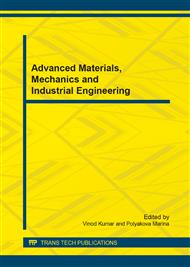p.13
p.18
p.23
p.28
p.33
p.38
p.43
p.47
p.51
The Viability of Composite Membrane in Treating Produced Water from Oil and Gas Field in Malaysia
Abstract:
As the oil and gas industry grows rapidly worldwide over the years, the production of produced water is also increasing. Million barrels of water are produced each day worldwide. This situation has become a major problem and a to the environment and ecosystem. Produced water contains many constituents such as dispersed oil, metals and chemicals that have a high toxicity and very harmful to the marine life. Therefore, it must be treated prior disposal to the environment or reinjection into the well and formation. There are many methods of treatments such as liquid-liquid hydrocyclone, floatation technology and membrane technology. Membrane technology is quite a new technology for the treatment of produced water in oil and gas industry. This paper is focused on the viability of using composite membranes which are Polysulfone (PSU), Polysulfone-bentonite (PSU-bentonite), PSU-PVP (Polysulfone-Poly vinyl pyrrolidone) and Polysulfone-Poly vinyl pyrrolidone-bentonite (PSU-PVP-bentonite) for the treatment of produced water. The objectives of this study are; 1) to characterize the produced water, 2) to prepare and cast the composite membrane and 3) to investigate the membrane performance in treating the produced water. The performance of the composite membrane were tested by using the produced water as wastewater feed and the best composite membrane is determined by the membrane performance. In the membrane preparation process, a method have been used namely phase inversion method. This research found that technically composite membrane have a good potential to be used in treating produced water from Malaysian oil and gas field. Thus, further technical and economic study on this treatment method is suggested for industrial scale application.
Info:
Periodical:
Pages:
33-37
Citation:
Online since:
July 2014
Keywords:
Price:
Сopyright:
© 2014 Trans Tech Publications Ltd. All Rights Reserved
Share:
Citation:


